Statistical-Synoptic Analysis of the Atmosphere Thickness Pattern of Iran’s Pervasive Frosts
Abstract
:1. Introduction
2. Materials and Methods
- 1.
- Environmental data: This group of data was obtained through interpolation of values of daily minimum temperatures registered in stations from 1961 to 2010. The data over these 50 years, which were collected from 450 synoptic and climatology stations of Iran’s Meteorological Organization (IRIMO), were sorted and interpolated (Figure 1). The data of this database have a spatial resolution of 15 km × 15 km, which have been produced in the form of Lambert Conformal Conic Projection, and arranged in the form of a 7187 × 18262 matrix with an S makeup (time in rows and place in columns). After collecting the data, the next step was identifying frosts in each of the cells. In the majority of climate studies, an important part of the research is defining the studied variable because it will influence other research steps. Many researchers have considered temperatures below 0 °C as the cut-off criterion for identifying frosts [26,27]. In the current study, a condition should meet the following three criteria to be considered as an example of frost in Iran:
- The temperature in the particular day should be less than 0 °C.
- This low temperature should last for at least two consecutive days.
- The temperature should have a minimum coverage of 50% (with the assumption of spatial continuity).
- 2.
- Weather data: This part of the data, which was used for calculating atmosphere thickness, consisted of hPa geopotential height data and were obtained from National Centers for Environmental Prediction/National Center for Atmospheric Research (NCEP/NCAR). These data have a spatial resolution of 2.5 × 2.5 degree of arc. Considering the research topic, the researchers intended to include all of the systems that are effective in the formation and continuation of frost waves in Iran. Therefore, the study covered the atmospheric system ranging from −10 degrees west longitude to 100 degrees east longitude and 10 to 70 degrees north latitude. Another group of maps that is used in synoptic climatology is thickness maps. They indicate atmosphere thickness, which usually ranges from 500 to 100 hPa. This is the thickness that is considered for the entire atmosphere. In other words, studying the thickness between these two layers (500 and 1000 hPa) is representative of the status of all layers. The following equation, which is known as hypsometric equation, is used to calculate atmosphere thickness:
3. Results and Discussion
3.1. The First Pattern: Siberian High-Pressure and European High-Pressure
3.2. The Second Pattern: Deep Trough Pattern of Eastern Europe and Sudanese Low Pressure
3.3. The Third Pattern: Dual-Core Pattern of Siberian High-Pressure
3.4. The Fourth Pattern: Deep Eastern European Trough and Polar Low Pressure Pattern
3.5. The Fifth Pattern: Omega Pattern
4. Conclusions
Acknowledgments
Author Contributions
Conflicts of Interest
References
- Masoodian, S.A.; Darand, M. The relationship two patterns of the North Sea—Caspian and East Europe—North East of Iran with occurrence frequency of extreme frost cold period of year Iran. J. Phys. Earth Space 2013, 2, 171–186. [Google Scholar]
- Azizi, Q.; Raziee, T. Zoning precipitation regime west of Iran by using principal components analysis and clustering techniques. J. Res. Water Resour. Iran 2007, 2, 1–4. [Google Scholar]
- Mohammadi, B. Identify anomalies spatiotemporal sea level pressure in Iran. Geogr. Res. Q. 2014, 1, 43–58. [Google Scholar]
- Chang, C.P.; Erickson, J.E.; Lau, K.M. Northeasterly cold surges and near-equatorial disturbances over the winter MONEX area during December 1974. Part I: Synoptic aspects. Mon. Weather Rev. 1979, 107, 812–829. [Google Scholar] [CrossRef]
- Park, T.-W.; Jeong, J.-H.; Ho, C.-H.; Kim, S.-J. Characteristics of atmospheric circulation associated with cold surge occurrences in East Asia: A case study during 2005/06 winter. Adv. Atmos. Sci. 2008, 25, 791–804. [Google Scholar] [CrossRef]
- Pandžić, K.; Trninić, D. The relationship between the Sava River basin annual precipitation, its discharge and the large-scale atmospheric circulation. Theor. Appl. Climatol. 1998, 61, 69–76. [Google Scholar] [CrossRef]
- Davis, R.E. Predictability of sea surface temperature and sea level pressure anomalies over the North Pacific Ocean. J. Phys. Oceanogr. 1976, 6, 249–266. [Google Scholar] [CrossRef]
- Blasing, T.J. Characteristic anomaly patterns of summer sea-level pressure for the northern hemisphere. Tellus 1981, 33, 428–437. [Google Scholar] [CrossRef]
- Maheras, P.; Kutiel, H. Spatial and temporal variations in the temperature regime in the mediterranean and their relationship with circulation during the last century. Int. J. Climatol. 1999, 19, 745–764. [Google Scholar] [CrossRef]
- Labajo Salazar, J.L.; Piorno, A.; Labajo, A.L.; Ortega, M.T. Analysis of the behavior of the extreme values of minimum daily atmospheric pressure at ground level over the Spanish Central Plateau. Atmosfera 2009, 22, 125–139. [Google Scholar]
- Jones, D.A.; Simmonds, I. Time and space spectral analyses of southern hemisphere sea level pressure variability. Mon. Weather Rev. 1993, 121, 661–672. [Google Scholar] [CrossRef]
- Rusticucci, M.M.; Venegas, S.A.; Vargas, W.M. Warm and cold events in argentina and their relationship with South Atlantic and South Pacific Sea surface temperatures. J. Geophys. Res. Oceans 2003, 108, 1–10. [Google Scholar] [CrossRef]
- Prieto, L.; Herrera, R.G.; Diaz, J.; Hernandez, E.; del Teso, T. Minimum extreme temperatures over Peninsular Spain. Glob. Planet. Chang. 2004, 44, 59–71. [Google Scholar] [CrossRef]
- Prieto, L.; Herrera, R.G.; Diaz, J.; Hernandez, E.; del Teso, T. NAO influence on extreme winter temperatures in Madrid (Spain). Ann. Geophys. 2002, 20, 2077–2085. [Google Scholar] [CrossRef]
- Guirguis, K.; Gershunov, A.; Schwartz, R.; Bennett, S. Recent warm and cold daily winter temperature extremes in the Northern Hemisphere. Geophys. Res. Lett. 2011, 38, 1–6. [Google Scholar] [CrossRef]
- Pezza, A.B.; Ambrizzi, T. Dynamical conditions and synoptic tracks associated with different types of cold surge over tropical South America. Int. J. Climatol. 2005, 25, 215–241. [Google Scholar] [CrossRef]
- Shahbaiye Kotanaie, A. Synoptic Analysis of Winter Cold Waves in Iran, Synoptic Climatology. Master’s Thesis, Department of Geography, University of Zanjan, Zanjan, Iran, 2014. [Google Scholar]
- Akbari, T.; Masoodian, S.A. Identify role northern hemisphere teleconnection patterns on the temperature of Iran. Isfahan Univ. Res. J. 2007, 12, 117–123. [Google Scholar]
- Masoodian, S.A.; Darand, M. Analysis of sea level pressure anomalies on days with extreme frost occurrence Iran. J. Geogr. Environ. Plan. 2012, 1, 1–14. [Google Scholar]
- Montazeri, M.; Masoodian, S.A. Detect patterns of thermal advection of cold years Iran. Phys. Geogr. Res. Q. 2010, 74, 79–94. [Google Scholar]
- Ghavidel Rahimi, Y. The relationship of at least pervasive extreme temperatures cold period Azerbaijan region with circulation patterns 500 hPa. J. Res. Geogr. Space 2010, 35, 155–184. [Google Scholar]
- Azizi, Q.; Akbari, T.; Davodi, M.; Akbari, M. Synoptic analysis of severe cold waves of January 1386 of Iran. Phys. Geogr. Res. Q. 2009, 70, 1–20. [Google Scholar]
- Imam Hadi, M.; Alijani, B. Air masses affecting Iran in the cold period of the year. Geogr. Res. J. 2004, 75, 34–53. [Google Scholar]
- Khosravi, M.; Doustkamian, M.; Mirmousavi, S.H.; Biat, A.; Biek, R.E. Classification of temperature and precipitation in Iran by using geostatistical methods and cluster analysis. J. Reg. Plan. 2014, 13, 121–132. [Google Scholar]
- Khoshhal Dastjerdi, J.; Yazdanpanah, H.; Hatami, K.; Biglo, B. Identification circulation patterns freezing phenomenon by using principal component analysis and cluster analysis (A case study: Fars province). J. Nat. Geogr. 2010, 12, 27–38. [Google Scholar]
- Vincent, L.A.; Peterson, T.C.; Barros, V.R.; Marino, M.B.; Rusticucci, M.; Carrasco, G.; Ramirez, E.; Alves, L.M.; Ambrizzi, T.; Berlato, M.A. Observed trends in indices of daily temperature extremes in South America 1960–2000. J. Clim. 2005, 18, 5011–5023. [Google Scholar] [CrossRef]
- Alijani, B. Spatial analysis of daily temperatures and precipitation Iran. J. Appl. Res. Geogr. Sci. 2011, 17, 9–30. [Google Scholar]
- Takaya, K.; Nakamura, H. Mechanisms of intraseasonal amplification of the cold Siberian high. J. Atmos. Sci. 2005, 62, 4423–4440. [Google Scholar] [CrossRef]
- Ghanghermeh, A.A.; Roshan, G.R.; Shahkooeei, E. Evaluation of the effect of Siberia’s high pressure extension on daily minimum temperature changes in Iran. Model. Earth Syst. Environ. 2015, 1, 1–15. [Google Scholar] [CrossRef]
- Soleyman, S.; Hosseinzadeh, S.R.; Doostan, R.; Ahangarzadeh, Z. Synoptic analysis of cold waves in the Northeast of Iran. Geogr. Environ. Hazards 2012, 3, 17–19. [Google Scholar]
- Masoodian, S.A. The identification of the precipitation regime in Iran to cluster analysis method. Phys. Geogr. Res. Q. 2005, 52, 47–59. [Google Scholar]
- Hejazizadeh, Z.; Naserzadeh, M.H. Analysis of frost in Lorestan province. Geogr. Sci. 2006, 6, 31–47. [Google Scholar]
- Hojabrpour, G.; Alijani, B. Synoptic analysis of Ardabil provience frosts. Geogr. Dev. 2007, 10, 89–106. [Google Scholar]
- García, I.P. Major cold air outbreaks affecting coffee and citrus plantations in the eastern and northeastern México. Atmosfera 2009, 9, 47–68. [Google Scholar]
- Lashkari, H.; Yarmoradi, Z. Synoptic analysis Siberian high pressure Location and input paths to Iran in the cold season. Phys. Geogr. Res. Q. 2014, 2, 199–218. [Google Scholar]
- Alijani, B.; Farajzadeh, H. Trend analysis of extreme temperature indicators in northern Iran. Geogr. Manag. 2014, 52, 229–256. [Google Scholar]
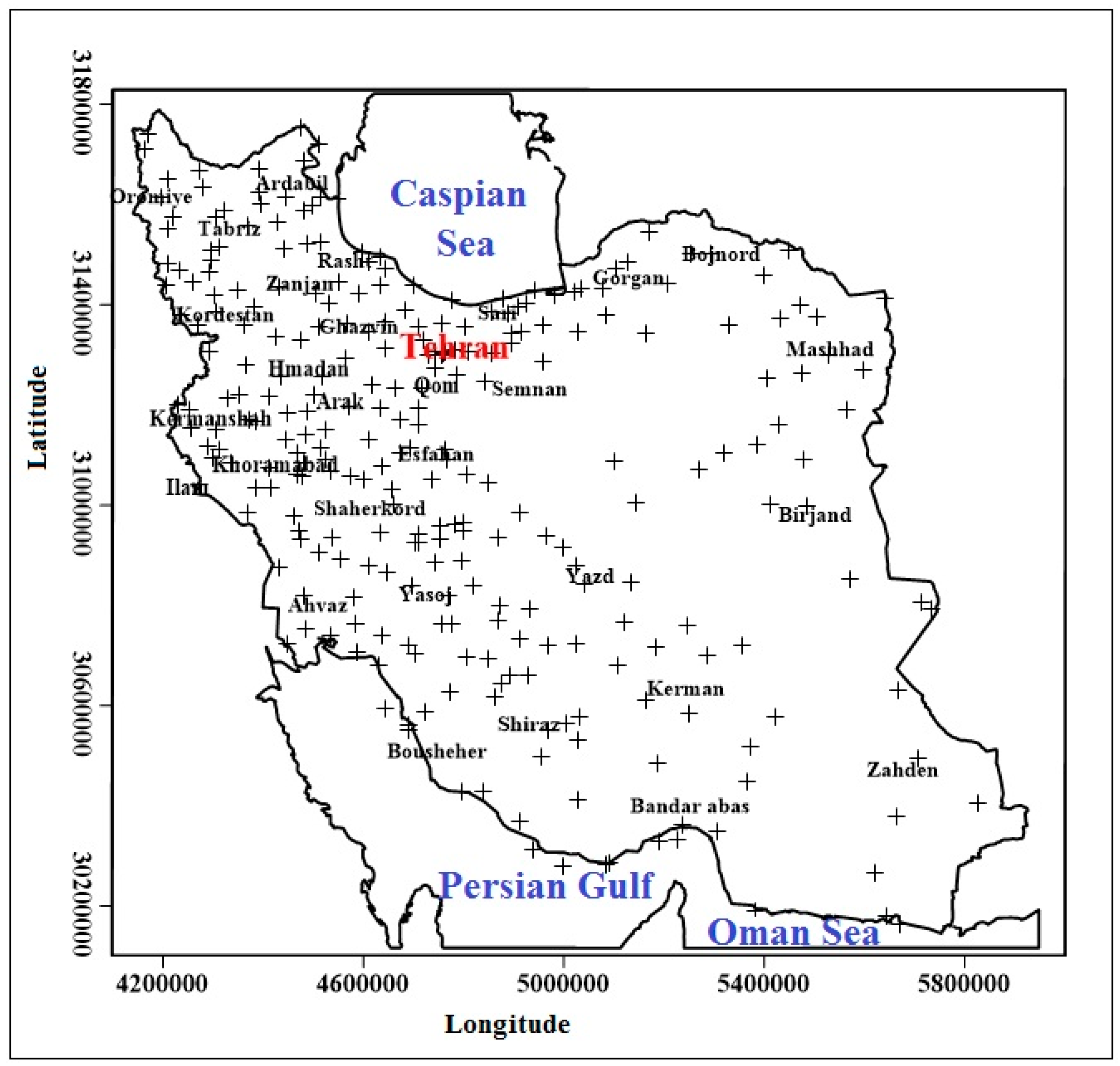
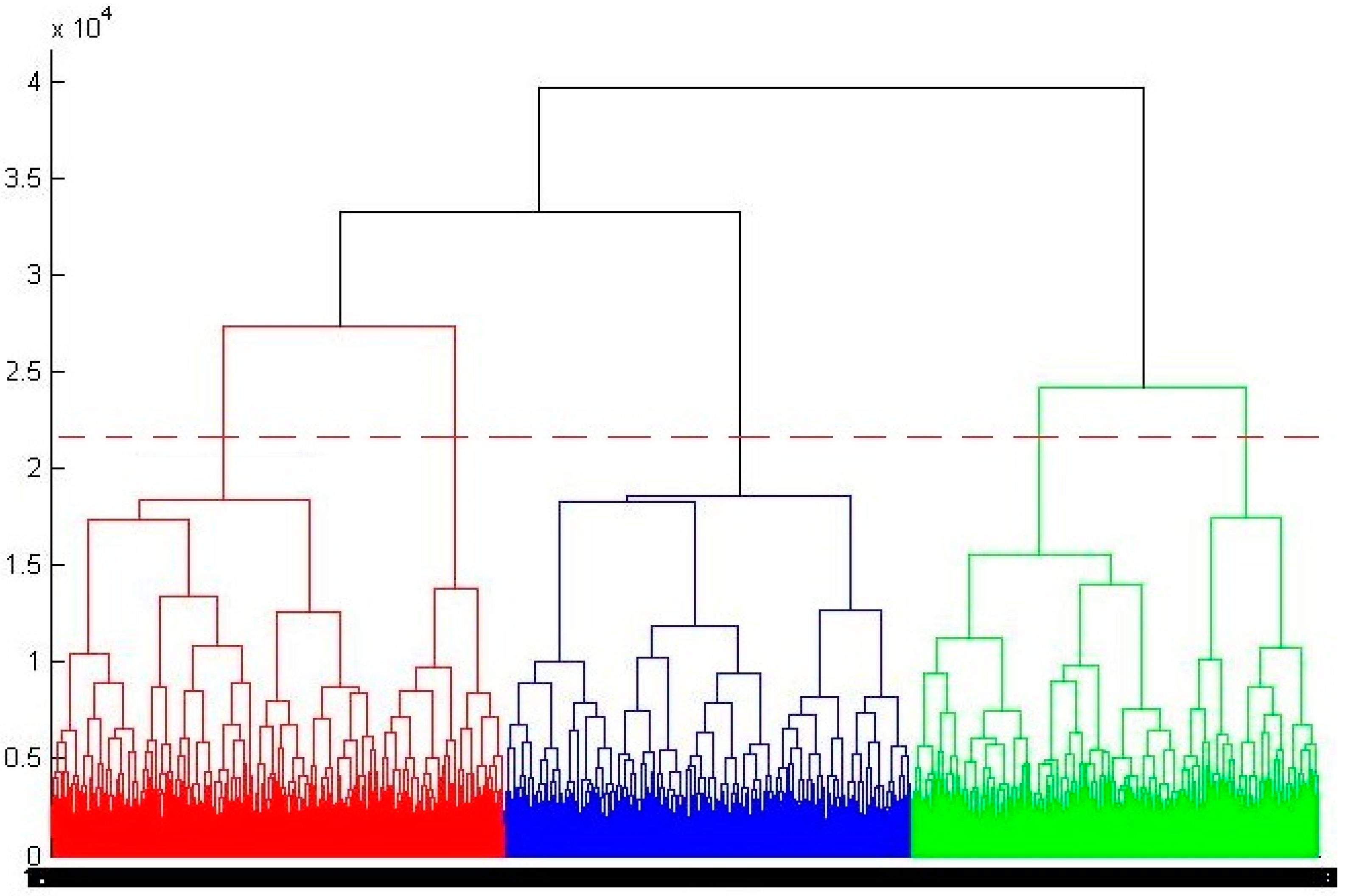
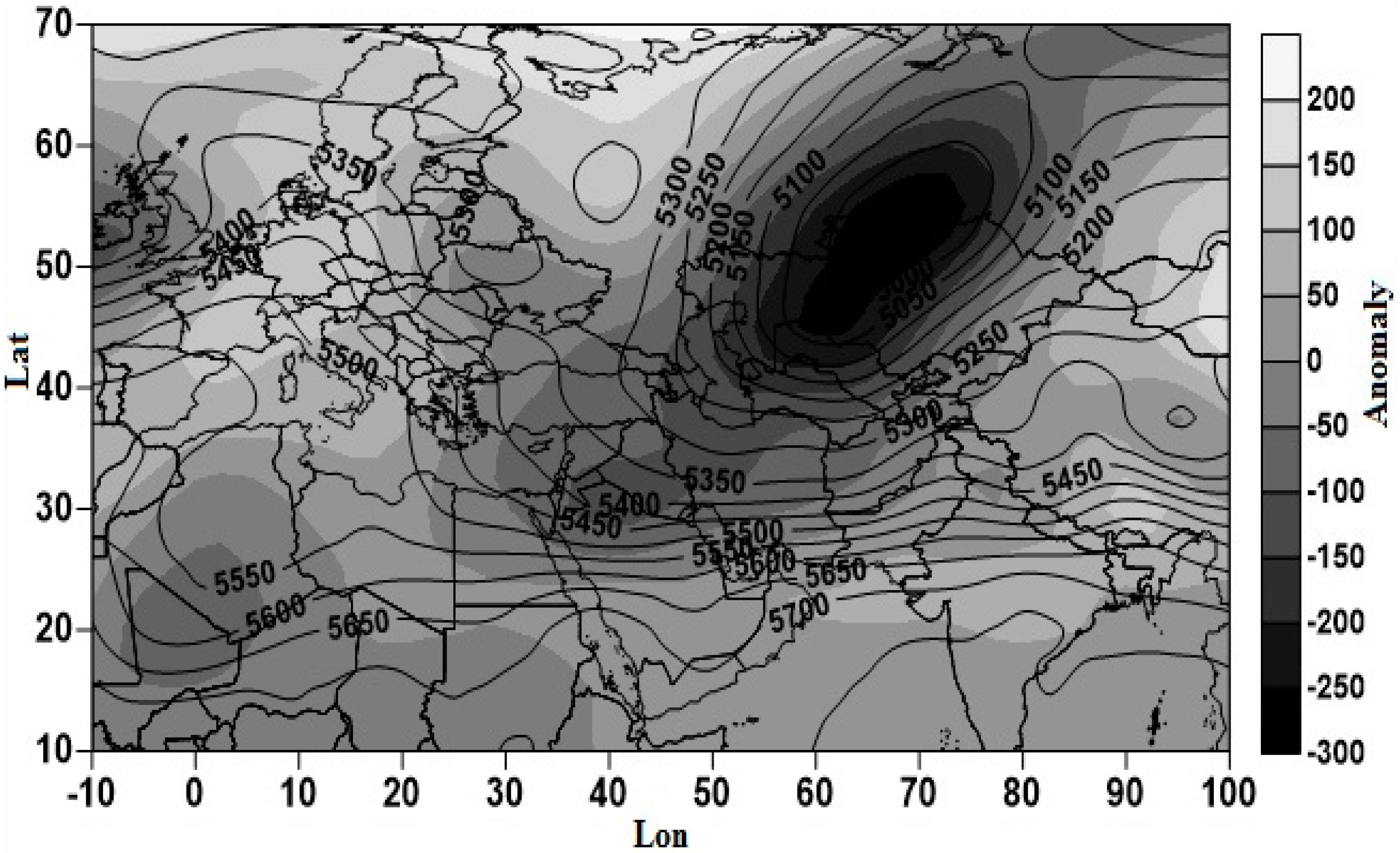
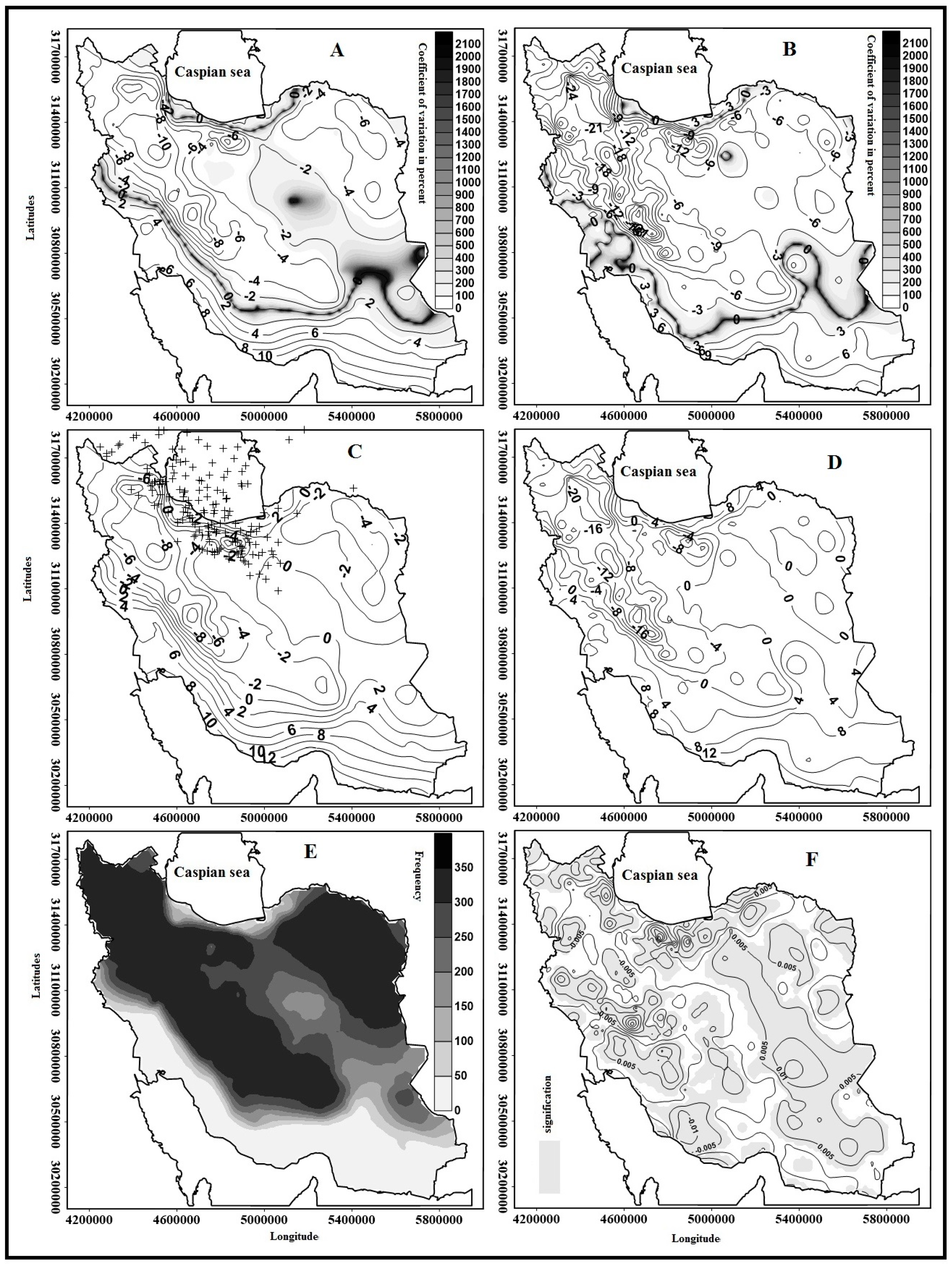
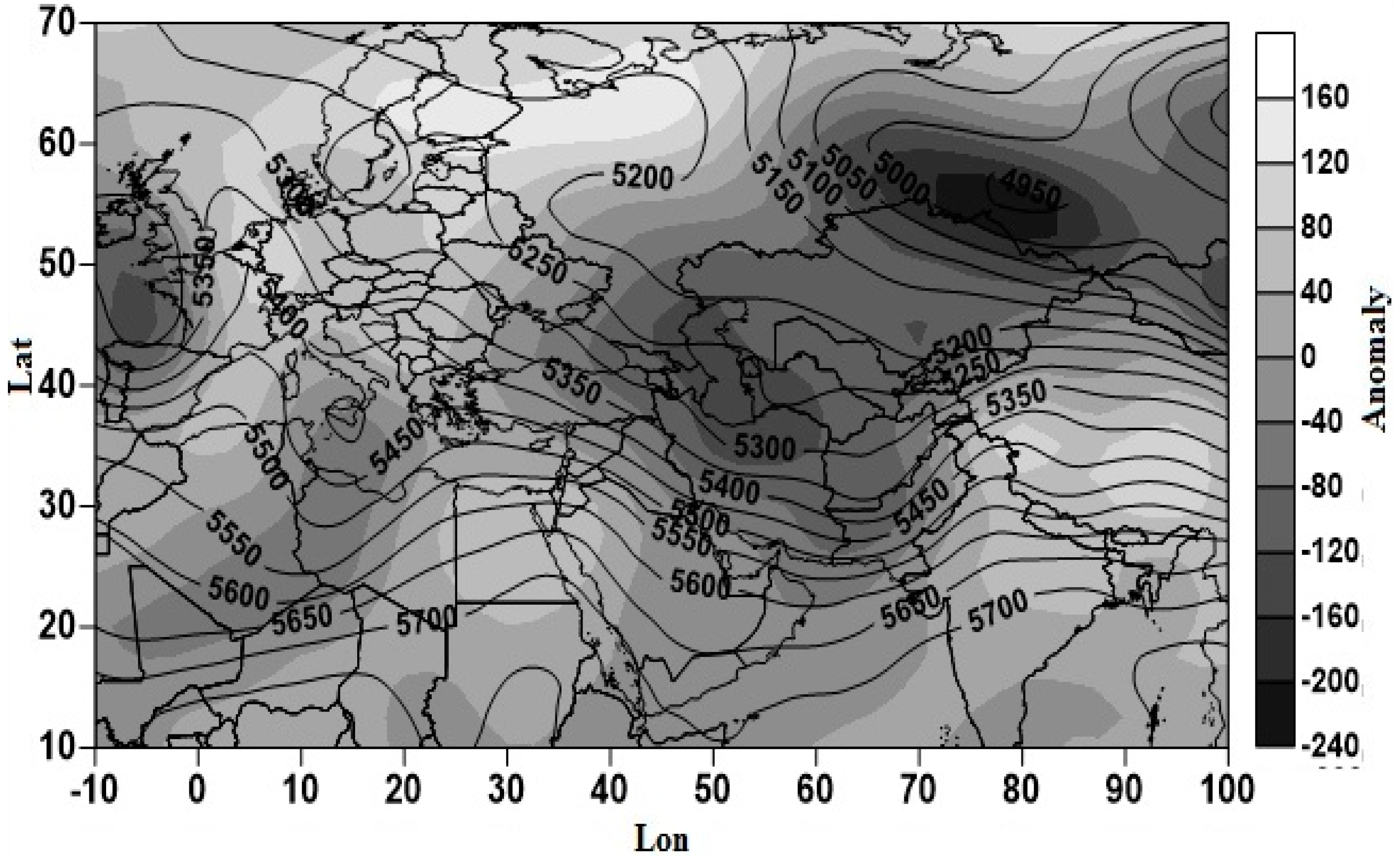
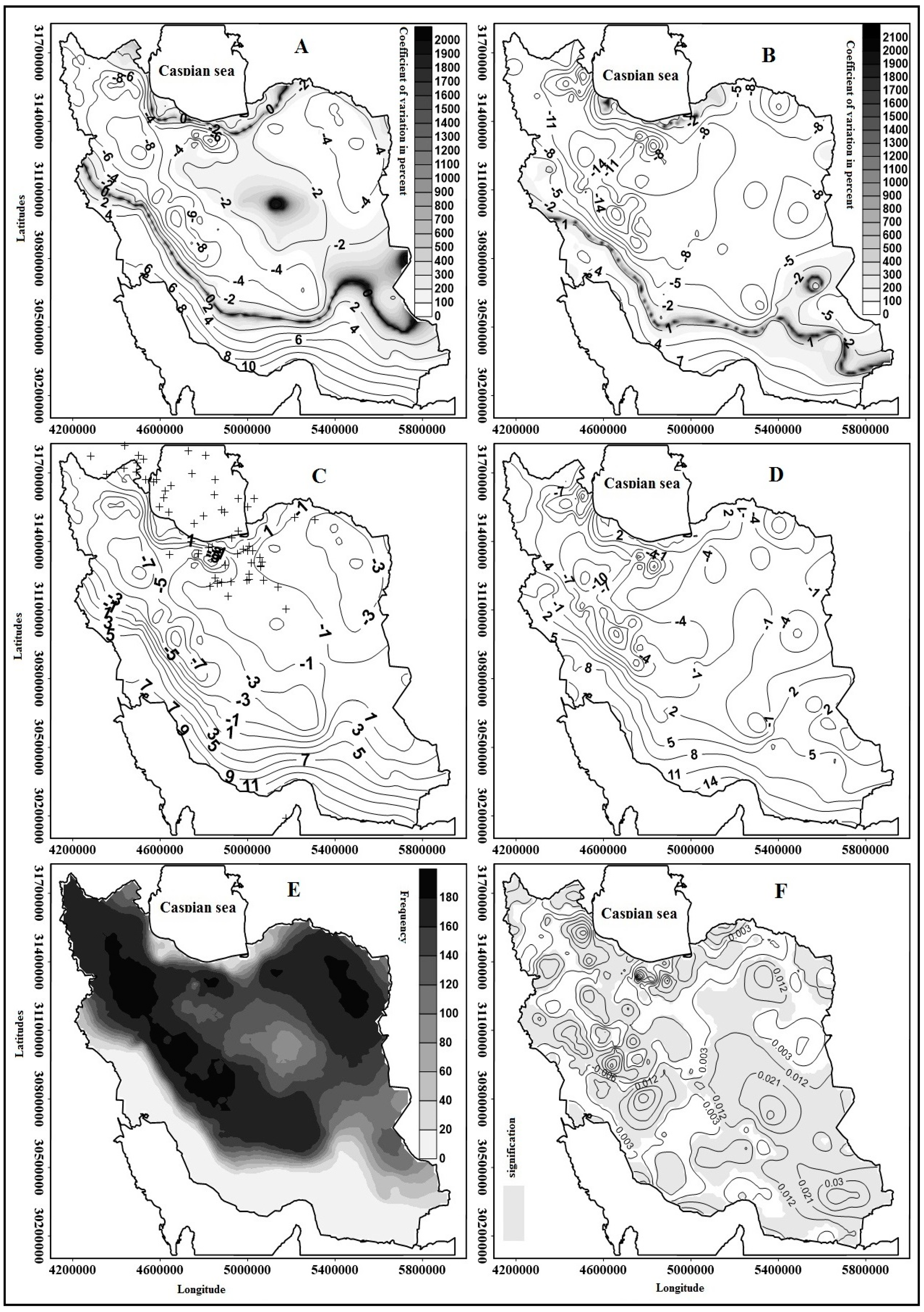
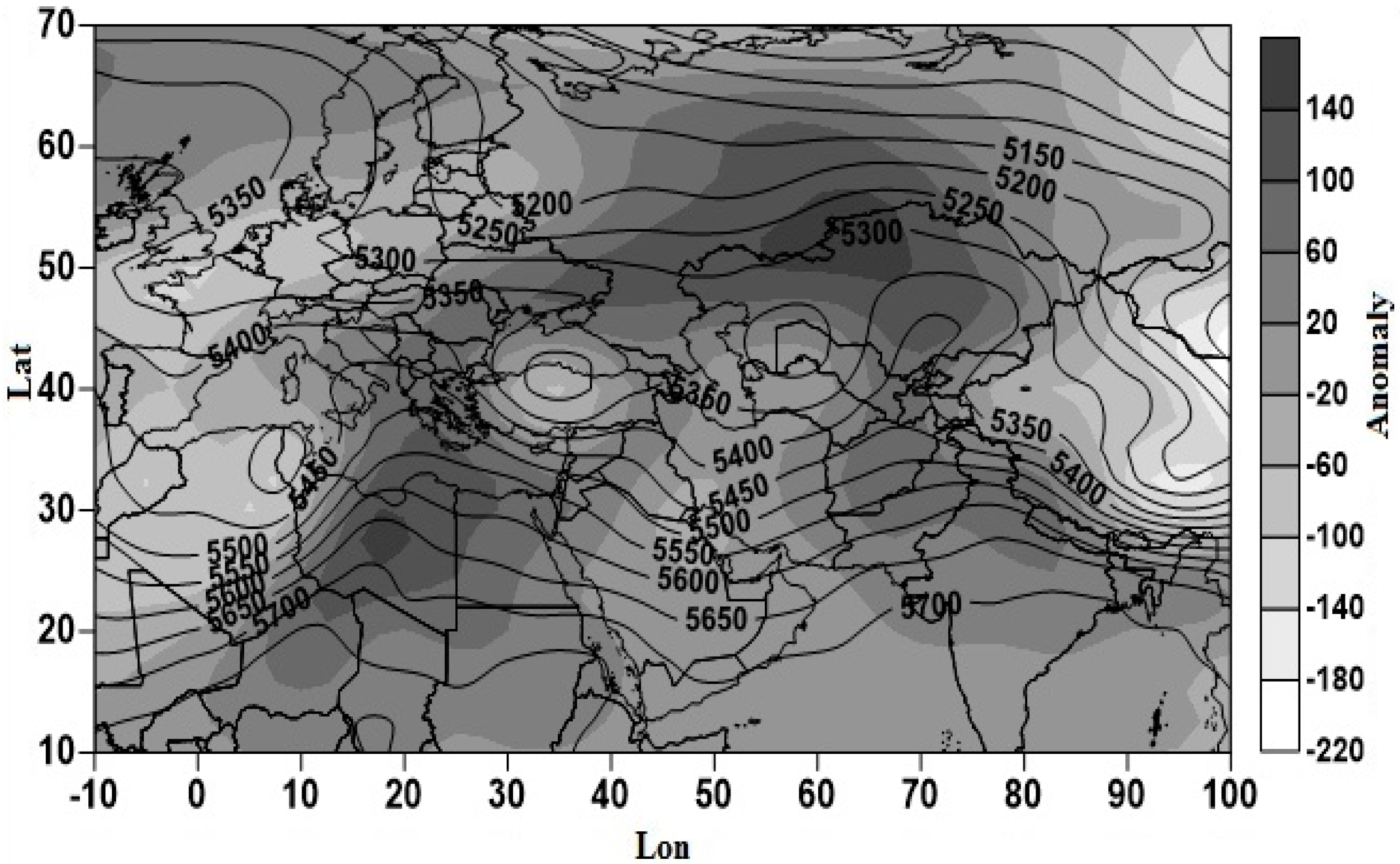
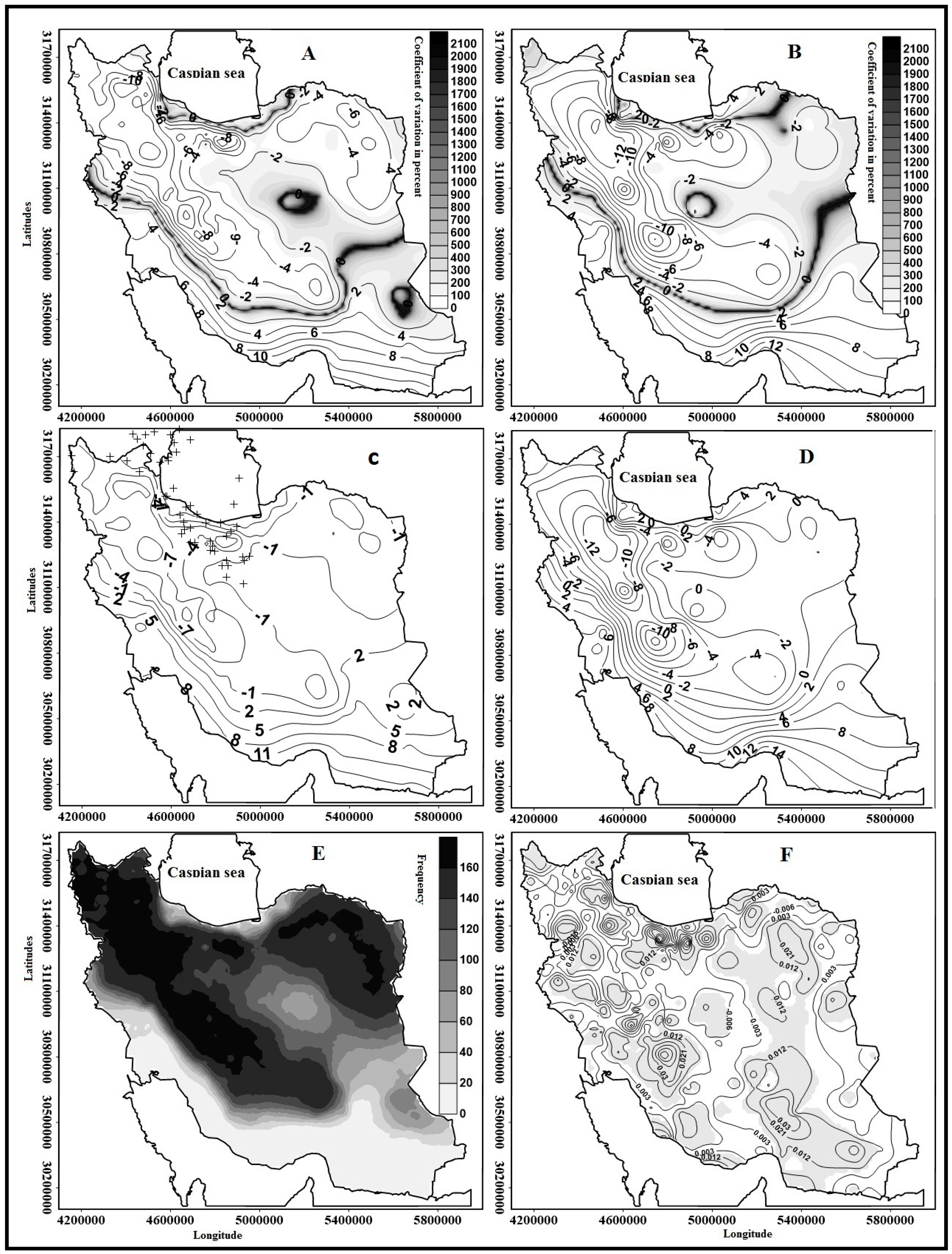
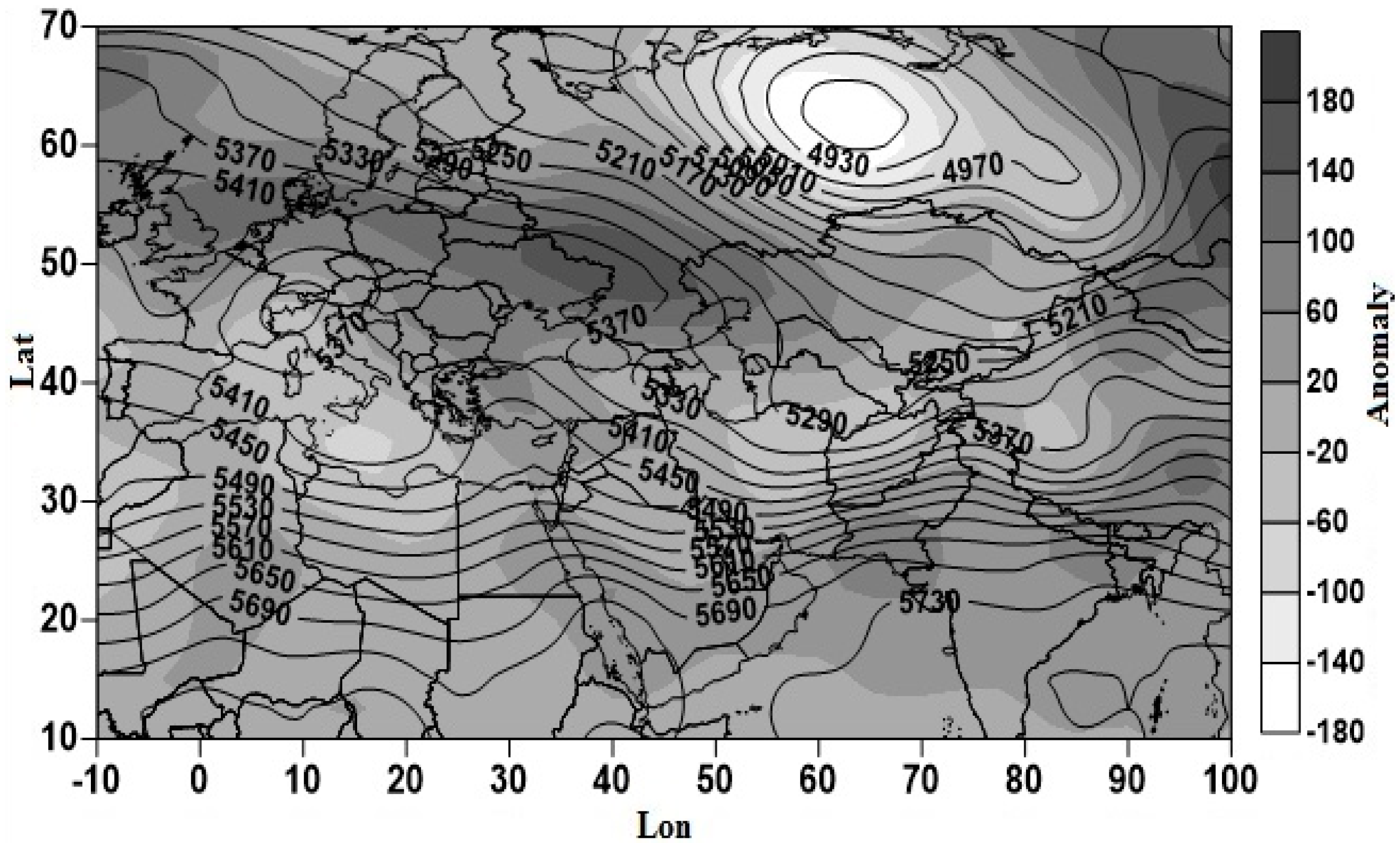
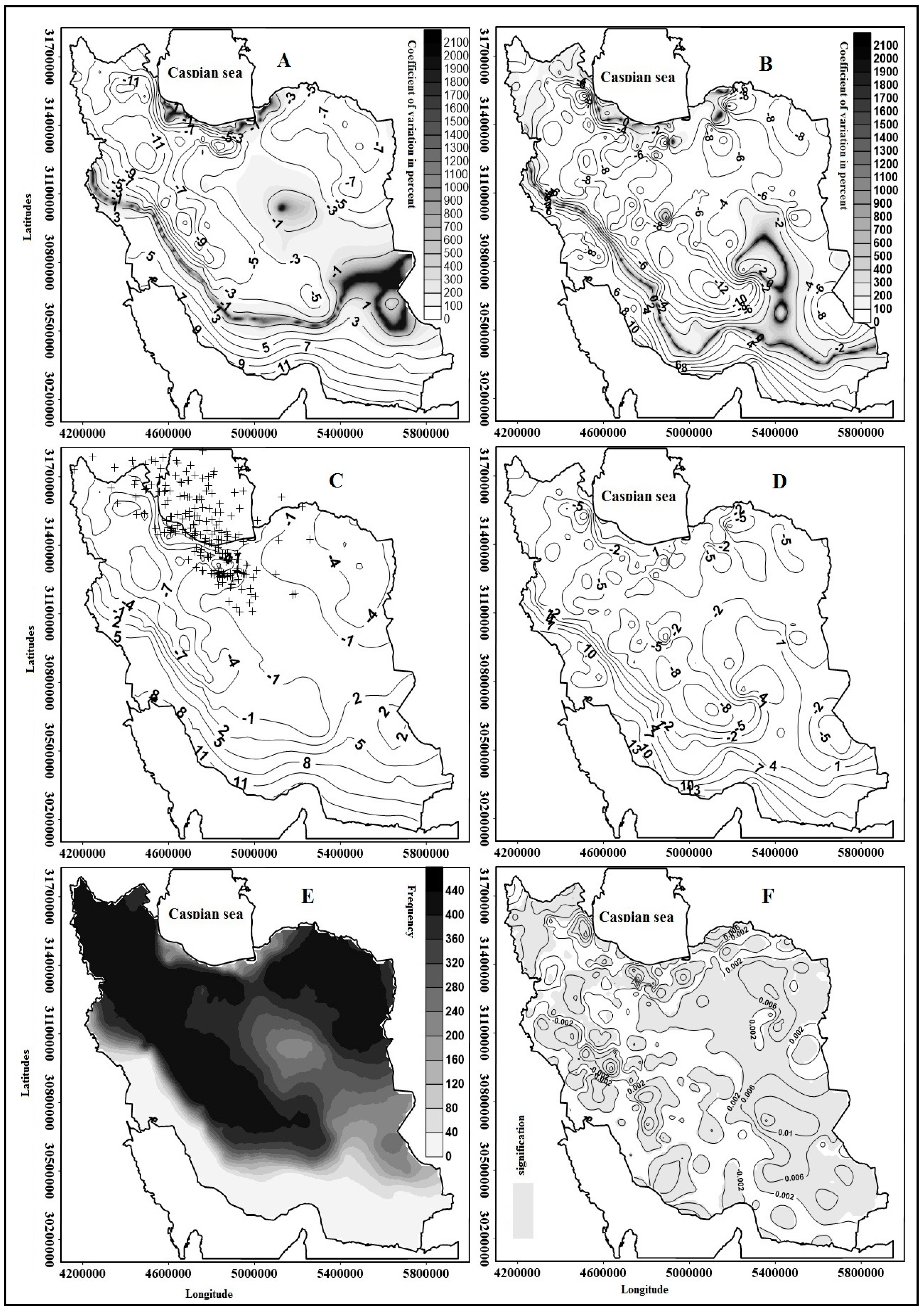
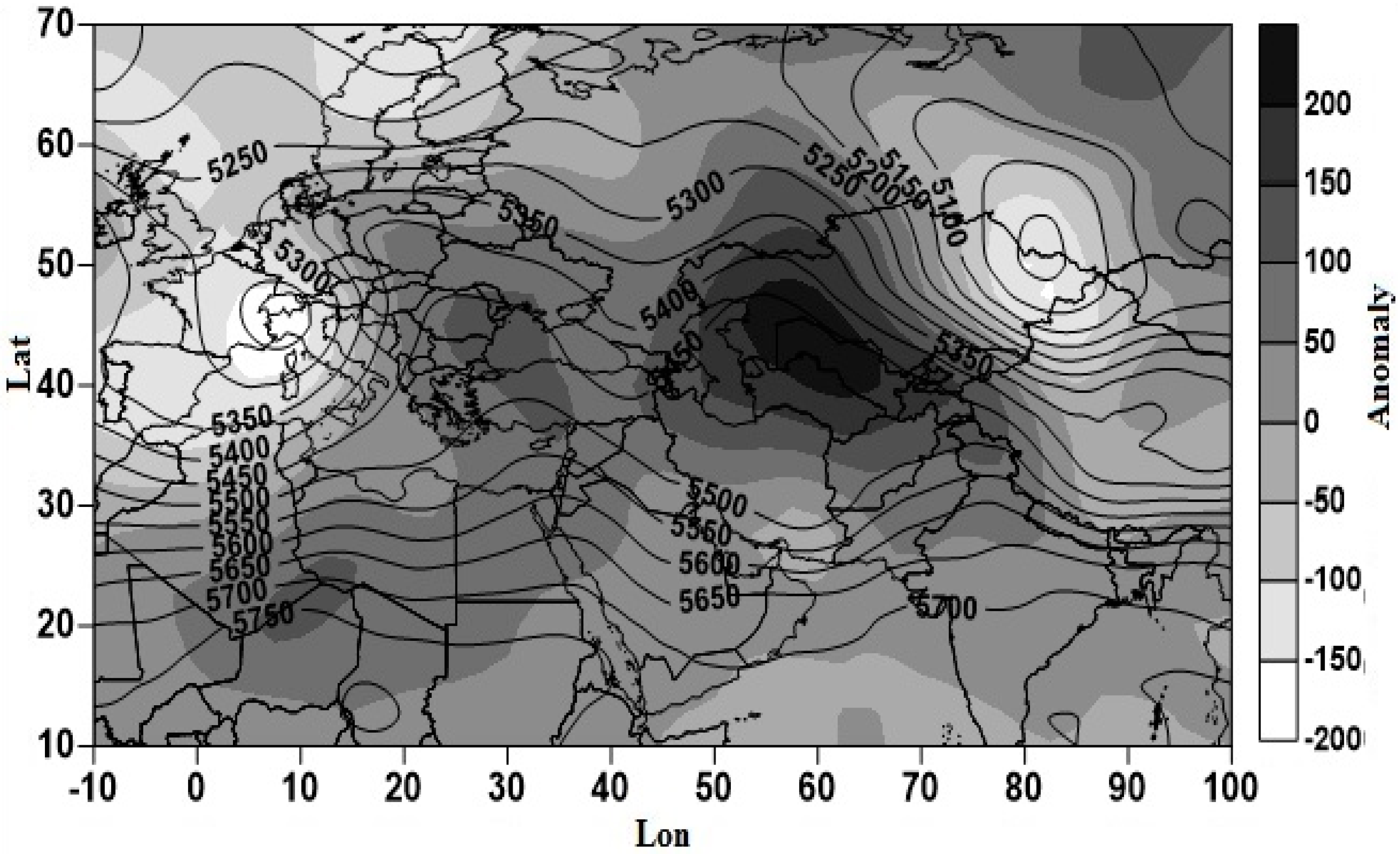
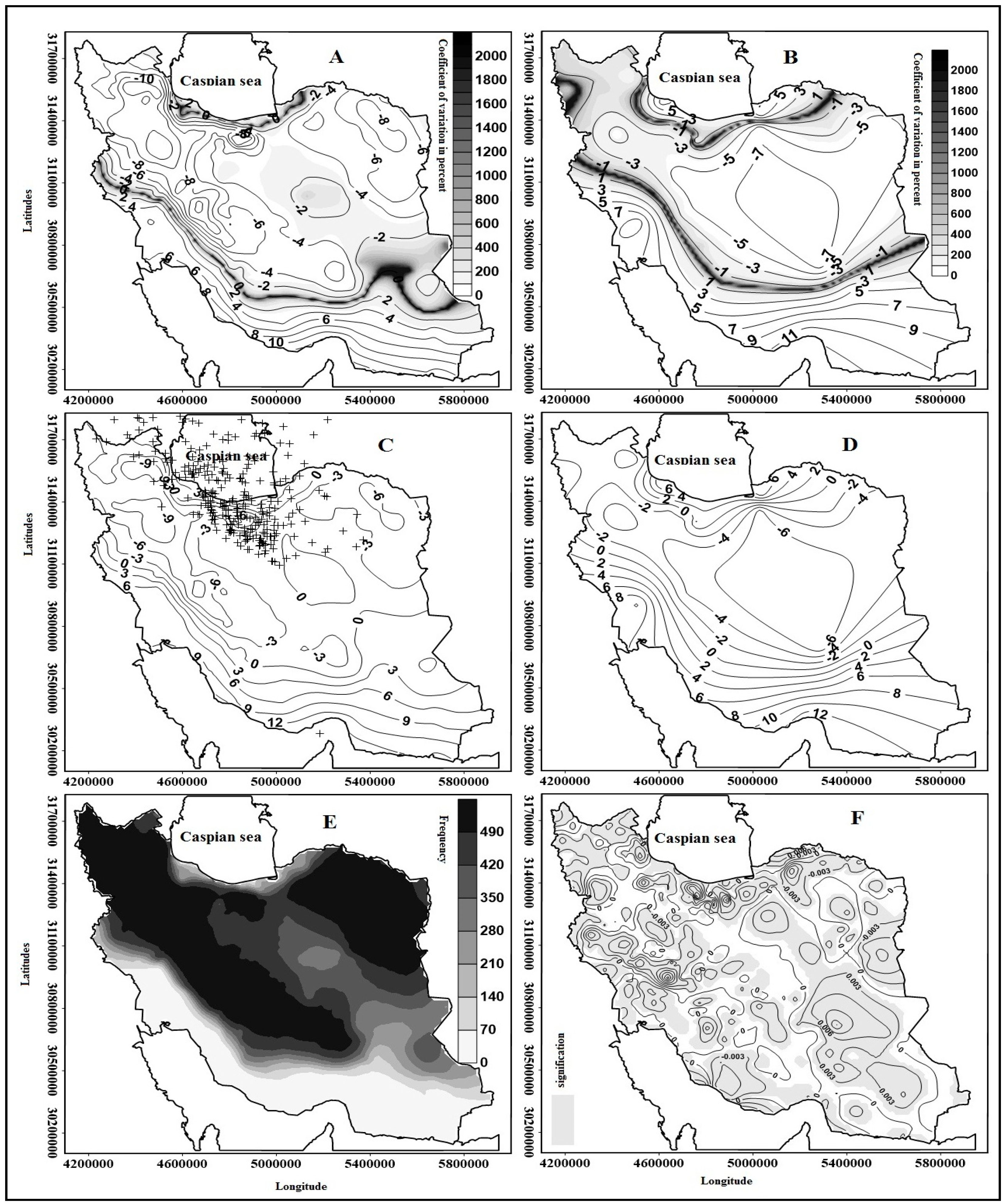
| Pattern | The Whole Frost Event (%) | The Date of the Representative Day | The Coverage of the Representative Day (%) | Frequency | Average Temperature of the Representative Day | Average Temperature of the Group |
|---|---|---|---|---|---|---|
| Siberian high-pressure and European high-pressure | 20.9 | 1 January 2007 | 75.93 | 339 | −1.73 | −5.05 |
| Deep trough pattern of Eastern Europe and Sudanese low | 11.09 | 13 November 1972 | 57.84 | 180 | −1.07 | −4.20 |
| Dual-core pattern of Siberian high-pressure | 10.04 | 4 January 1986 | 63.36 | 163 | −1.45 | −0.93 |
| Deep Eastern European trough and polar low pressure pattern | 25.77 | 22 February 1961 | 79.95 | 418 | −2.06 | 0.51 |
| Omega pattern | 32.18 | 22 December 1960 | 59.81 | 522 | −2.30 | −3.30 |
| Overall Temperature of the First Group | Area (%) | Representative Day Temperatures | Area (%) |
| −13.21 to −7.69 | 10.8 | −27.28 to −19.91 | 5.3 |
| −2.17 to −7.69 | 41.1 | −19.91 to −11.11 | 11.8 |
| 3.34 to −2.17 | 30.5 | −11.1 to −2.31 | 48.6 |
| 8.87 to 3.34 | 13.1 | −2.31 to 6.51 | 28.8 |
| 14.4 to 8.87 | 4.5 | 6.51 to 15.32 | 5.5 |
| The Frequency of Frost Days | Area (%) | Representative Day Anomaly | Area (%) |
| 0 to 69 | 20.5 | Negative anomalies | 56.4 |
| 69 to 139 | 5.5 | Positive anomalies | 43.6 |
| 139 to 209 | 8.8 | Anomalies the whole group | Area (in percentage) |
| 209 to 279 | 14.3 | Negative anomalies | 47.2 |
| 279 to up | 50.9 | Positive anomalies | 52.8 |
| Overall Temperature of the Second Group | Area (%) | Representative Day Temperatures | Area (%) |
| −5.93 to −11.13 | 12.3 | −19.19 to −28.72 | 5.3 |
| −0.76 to −5.93 | 51.4 | −11.8 to −19.19 | 11.8 |
| 4.46 to −0.76 | 21.1 | −2.31 to −11.8 | 48.6 |
| 9.66 to 4.46 | 11.1 | 6.50 to −2.31 | 28.8 |
| 14.87 to 9.66 | 4.1 | 15.32 to 6.50 | 5.5 |
| The Frequency of Frost Days | Area (%) | Representative Day Anomaly | Area (%) |
| 36 to 0 | 21.1 | Negative anomalies | 57.9 |
| 72 to 36 | 6.1 | Positive anomalies | 42.1 |
| 110 to 72 | 8 | Anomalies the entire group | Area (%) |
| 145 to 110 | 18.5 | Negative anomalies | 60.4 |
| 145 To up | 46.3 | Positive anomalies | 39.6 |
| Overall Temperature of the Third Group | Area (%) | Representative Day Temperatures | Area (%) |
| −8.45 to −13.82 | 11.3 | −10.73 to −17.06 | 5 |
| −2.26 to −8.45 | 37.1 | −4.40 to −10.73 | 21.3 |
| 3.52 to −2.26 | 33.5 | 1.92 to −4.40 | 45.3 |
| 9.30 to 3.52 | 13.4 | 8.2 to 1.92 | 20.7 |
| 15.9 to 9.30 | 4.7 | 14.59 to 8.2 | 7.7 |
| The Frequency of Frost Days | Area (%) | Representative Day Anomaly | Area (%) |
| 32 to 0 | 21.4 | Negative anomalies | 69.6 |
| 62 to 32 | 8.2 | Positive anomalies | 30.1 |
| 97 to 62 | 9.7 | Anomalies the entire group | Area (%) |
| 130 to 97 | 11.2 | Negative anomalies | 64.5 |
| 163 to 130 | 49.6 | Positive anomalies | 35.5 |
| Overall Temperature of the Fourth Group | Area (%) | Representative Day Temperatures | Area (%) |
| −8.4 to −14.3 | 13.1 | −10.9 to −17.39 | 4 |
| −2.6 to −8.4 | 37 | −0.42 to −10.9 | 49 |
| 3.19 to −2.6 | 30.8 | 2.06 to −0.42 | 29.7 |
| 9.02 to 3.19 | 14.1 | 8.54 to 2.06 | 14.3 |
| 14.87 to 9.02 | 5 | 15.04 to 8.54 | 3 |
| The Frequency of Frost Days | Area (%) | Representative Day Anomaly | Area (%) |
| 85 to 0 | 20.6 | Negative anomalies | 67.7 |
| 171 to 85 | 5.3 | Positive anomalies | 32.3 |
| 256 to 171 | 9.7 | Anomalies the entire group | Area (%) |
| 342 to 256 | 13.2 | Negative anomalies | 65.7 |
| 428 to 342 | 51.3 | Positive anomalies | 34.3 |
| Overall Temperature of the Fifth Group | Area (%) | Representative Day Temperatures | Area (%) |
| −8.13 to −13.86 | 13.2 | −8.19 to −3.8 | 35 |
| −2.40 to −8.13 | 43.5 | −3.8 to 0.55 | 27.5 |
| 3.32 to −2.40 | 25.4 | 0.55to 4.9 | 15.8 |
| 9.05 to 3.32 | 13.4 | 9.29 to 4.9 | 13.6 |
| 14.79 to 9.05 | 4.5 | 9.29 to 13.68 | 8.2 |
| The Frequency of Frost Days | Area (%) | Representative Day Anomaly | Area (%) |
| 106 to 0 | 19.9 | Negative anomalies | 67.6 |
| 212 to 106 | 4.9 | Positive anomalies | 32.4 |
| 319 to 212 | 7.9 | Anomalies the entire group | Area (%) |
| 425 to 319 | 13.3 | Negative anomalies | 64.5 |
| 532 to 425 | 53.9 | Positive anomalies | 35.5 |
© 2016 by the authors; licensee MDPI, Basel, Switzerland. This article is an open access article distributed under the terms and conditions of the Creative Commons Attribution (CC-BY) license (http://creativecommons.org/licenses/by/4.0/).
Share and Cite
Rousta, I.; Doostkamian, M.; Haghighi, E.; Mirzakhani, B. Statistical-Synoptic Analysis of the Atmosphere Thickness Pattern of Iran’s Pervasive Frosts. Climate 2016, 4, 41. https://doi.org/10.3390/cli4030041
Rousta I, Doostkamian M, Haghighi E, Mirzakhani B. Statistical-Synoptic Analysis of the Atmosphere Thickness Pattern of Iran’s Pervasive Frosts. Climate. 2016; 4(3):41. https://doi.org/10.3390/cli4030041
Chicago/Turabian StyleRousta, Iman, Mehdi Doostkamian, Esmaeil Haghighi, and Bahare Mirzakhani. 2016. "Statistical-Synoptic Analysis of the Atmosphere Thickness Pattern of Iran’s Pervasive Frosts" Climate 4, no. 3: 41. https://doi.org/10.3390/cli4030041







